What’s the Best Deep-Cycle Battery for Solar?
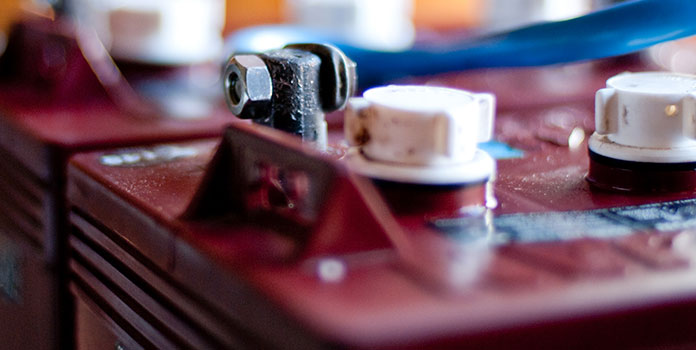
Are you interested in deep cycle batteries for solar?
If you’re thinking about going solar and want the best solar battery backup system, you have a lot of options! Deep cycle batteries, designed for regular and heavy discharge, are the only way to go. You’ll find them in places where heavy, daily use is expected: golf carts, boats, and of course, paired with solar installations and other renewable energy systems.
‘Deep-cycle’ isn’t a specific technology or battery type. Manufacturers produce deep-cycle batteries with a variety of technologies, from the common flooded lead-acid battery (like most of us have in our cars), completely sealed AGM batteries to more expensive lithium-ion batteries.
Let’s look at each type of deep-cycle battery a bit more in depth, as well as some of the best deep-cycle batteries in each category. If you want to really dive in to the technology behind deep-cycle batteries, check out our article Solar Batteries Lifespan: How Long Will Your Deep-Cycle Last?
Flooded Lead-Acid Batteries
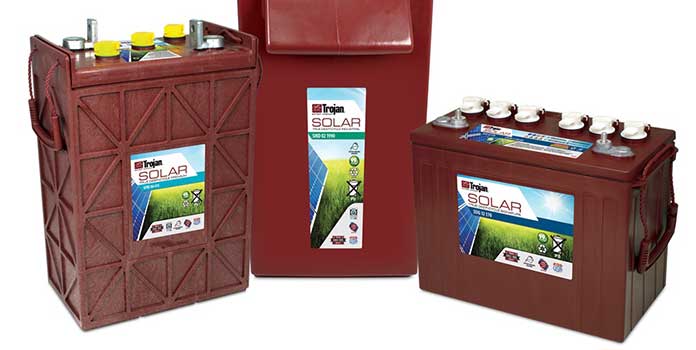
We’re all familiar with flooded lead-acid batteries – most of us use them in our cars every day (though those are starter batteries, not deep-cycle batteries). They’re cheap (compared to other battery types), reliable, and time-tested. However, they suffer from a few downsides if you want to use them for your solar backup.
These kind of batteries aren’t completely sealed (unlike the AGM batteries we’ll talk about below), so hydrogen and oxygen (ie water) can escape through the vents. Because they aren’t sealed, need regular maintenance, checking water levels and possibly adding water. That’s certainly not hard or complicated but you need to make time for this throughout the year.
Since they’re vented, you’ll need a special storage area that is safely open to the outside – you can’t just use flooded lead-acid batteries in your basement! They can also leak if turned on their sides, so you’ll need to ensure they’re situated in an upright position and in an area where they can’t tip over and leak the sulfuric acid inside.
All these quirks though can easily be worked out with a little planning and deep-cycle flooded lead-acid batteries give you the opportunity to create a reliable solar storage system with the lowest initial investment of all the different battery types on our list.
Let’s look at a couple of deep-cycle lead-acid batteries that are popular for energy storage:
Trojan Signature Series
Capacity/Voltage: 153Ah, 12v Lifecycle cost: $0.26 per 100 Amp-hours ($240; 1200 cycles @ 50% DoD) Warranty: 1 year replacement, 1 year prorated
Trojan is well-known in the battery community for making well-priced, extremely reliable products. They’re respected and, because they are so popular, are known to stand the test of time.
Their prolific T-105RE battery, a golf cart-sized battery specifically manufactured for renewable applications, was (and still is) a huge hit. But they’ve moved on since then, and now offer a wide range of batteries specifically designed for solar storage.
Their Signature Series of solar batteries come in all sizes and voltages, offering a good option for your storage needs. With the 12 volt, 153Ah option coming in at an estimated 1,200 cycle life – a decent pull for lead-acid batteries. With their low initial cost and decent cycle life, their overall lifetime cost ($ per amp-hour over its entire lifetime) is pretty good for a smaller battery. At this rate, you could probably expect them to last 3 to 5 years if you treat them well.
Trojan offers two year warranties for the battery above, half of which is prorated. While nothing to write home about, 1 year replacement is on par with warranties from other manufacturers.
HUP
Capacity/Voltage: 845Ah, 12v Lifecycle cost: $0.16 per 100 Amp-hours ($2,679; 4,000 cycles @ 50% DoD) Warranty: 7 year replacement, 3 year prorated
One of the cheapest options when looking at lifetime cost (in $/Ah) thanks to their ultra-long cycle life (4,000 cycles!), HUP batteries are perfect if you’re looking for a long-term investment. They cost about 30% less than pretty much all the other batteries on our list. Spending almost $3k for a battery might seem like too much, but if you’re planning on using it to its full potential (and taking care of it so it can last), you’re going to have a great experience.
On top of all that, they offer exceptional, long-term warranties on their batteries – 7 year replacement and 3 years prorated. That’s a full 10 years of warranty – for a lead-acid battery no less!
The only downside (though it’s not really a downside) is their size: HUP only makes large capacity batteries. With that in mind, they’re overkill for small applications like campers or RVs that only run a few lights, phone, and computer. However, if you’ve got a mid- to large-scale system, HUP offers an incredible value for your cash.
AGM (Absorbed Glass Mat) Batteries
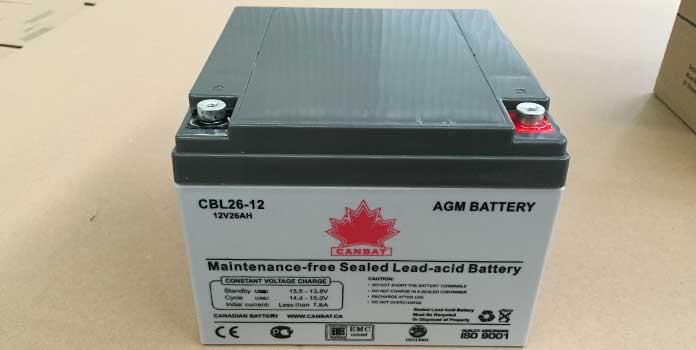
Moving on down the list of deep-cycle solar batteries, we come to AGM. AGM (absorbed glass mat, also known as ‘sealed batteries’ along with gel batteries) solve many of the issues plaguing the flooded lead-acid batteries we looked at above.
AGM batteries are still lead-acid batteries, as they have the same lead-water-sulfuric acid solution. However, between the lead plates, there are very fine layers of fiberglass mats. These mats soak up the electrolyte solution, preventing off-gassing and allowing the batteries to be completely sealed.
As such, they don’t require any maintenance – you don’t need to (and in fact, can’t) check water levels. Notice how, in the picture above, the battery lacks any sort of cap or vent cover on top.
Once it’s installed, you can basically forget them. This allows you to put these batteries in areas that are more difficult to access and, since they’re sealed, you can even install them on their sides.
With these awesome benefits, though, you’re also looking at a higher cost and (usually) a shorter lifespan. Let’s take a look at a few popular options.
Universal Battery
Capacity/Voltage: 100 Ah, 12v Lifecycle cost: $0.60 per 100 Amp-hours ($165; 550 cycles @ 50% DoD) Warranty: 1 year
Universal Batteries manufactures some of the cheapest AGM batteries on the market and, because of this, they’re some of the most popular as well. Even though they’re much lower priced than most other AGM batteries, they still get great reviews from customers.
Despite their popularity and in the end, you get what you pay for, as they lose capacity sooner than other AGM batteries, the above battery lasting a scant 550 cycles. Because of this capacity loss (and the fact that AGM batteries are just more expensive than flooded batteries), their long-term cost ($/Ah), is actually about 3x higher than the flooded batteries above!
Couple that with the extremely short warranty, and what looks like a great deal on the outset actually turns into something that is, well, not so good.
However, if you’re looking to buy your first solar batteries and really want AGM, Universal Batteries enjoy low initial cost, allowing you to spend the least amount possible to get your system up and running. By the time your batteries are ready to be replaced, you’ll have a better working knowledge of your system and your own electricity needs, so you’ll know exactly what batteries to get in the next round.
VMAXTANKS
Capacity/Voltage: 125 Ah, 12v Lifecycle cost: $0.50 per 100 Amp-hours ($280; 900 cycles @ 50% DoD) Warranty: 1 year
VMAXTANKS produce deep-cycle batteries that see great user reviews. If you studied the information above, you might’ve noticed what seemed like a paradox. VMAXTANKS’ sticker price is over $100 more than the Universal Battery above, but the lifecycle cost is actually lower. How is that?
If you compare the cycle life of the two batteries, you’ll see that the VMAXTANKS actually lasts about 2x as long as the Universal Battery. So, over the long term, you’ll actually save money if you go with the VMAXTANKS, though you’ll have to fork over more cash on the outset.
Lithium-Ion Batteries
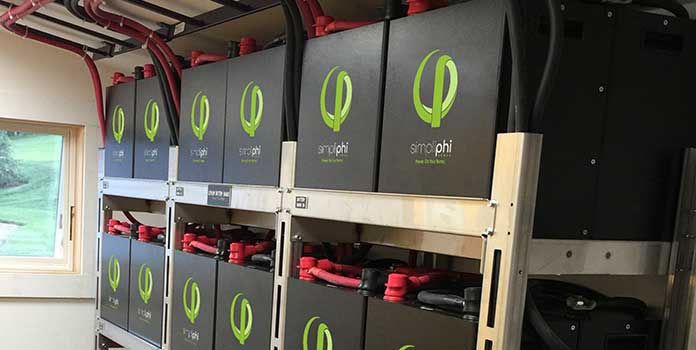
While their high price historically limited lithium batteries to small applications like cell phones, the recent burst of interest in electric vehicles – which use lithium batteries – and energy storage has pushed the price to the point where they’re available and cost-effective for even small applications.
Lithium batteries have a whole slew of benefits over their lead-acid brethren:
- Long cycle life – Lithium batteries typically last between 5,000 and 10,000 cycles. That’s 3x to 12x more than lead-acid batteries (depending on quality).
- High Depth of Discharge – Whereas lead-acid batteries should only be discharged down to 50% of their total capacity (meaning if you have a 100 amp-hour battery, you should only use 50 amp-hours regularly), lithium batteries can be repeatedly discharged to 80% of their total capacity without any negative long-term harm, meaning you can buy less batteries for the same amount of power.
- Fast charging – Compared to lead-acid batteries, lithium charges much faster.
- Smaller and Lighter– Lithium batteries can weigh 1/2 to a 1/3 of the typical lead-acid battery, and take up less space as well, so they’re easier to move around and less strain on your vehicle if you’re adding them to a camper, RV, or boat.
Of course, as with all good things, you’re paying for all these great benefits. But when you look at the long-term cost, lithium batteries are often as cheap as lead-acid batteries thanks to their long cycle life and higher depth of discharge (DoD).
Let’s look at a few.
Battle Born LiFePO4 Battery
Capacity/Voltage: 100 Ah, 12v Lifecycle cost: $0.23 per 100 Ah ($949; 4,000 cycles @ 100% DoD) Warranty: 3 year full replacement, 5 year prorated
Battle Born is a newcomer to the battery market, but they’re becoming more well-known thanks to their US-made batteries (Reno, NV) and excellent customer service. They only manufacture Lithium-Iron-Phosphate (LiFePO4) batteries, which cuts battery weight by half or more (only 29 lbs!) when compared to lead-acid.
Their initial price of $949 can come as a shock for just a 100 amp-hour battery, but their higher cycle life (4,000 cycles) drops the $/Ah cost to within reason. In fact, thanks to that long life and high Depth of Discharge, you’re looking at a lifetime cost that is very comparable to the cheapest lead-acid batteries, and much cheaper than sealed AGM batteries. But of course, you’re paying about 4x as much on the outset as well.
Like most lithium batteries, they come with a few additional perks, including built-in temperature protection (via an internal safety fuse that brakes if overheated) and high voltage protection (if high internal pressure is registered, the current is cut off). This helps ensure your battery will last as long as possible, even if you’re not setting up your system as precisely as you should.
SimpliPhi
Capacity/Voltage: 102.4Ah, 12v Lifecycle cost: $0.19 per 100 Amp-hours ($1545; 10,000 cycles @ 80% DoD) Warranty: 5 year replacement for 1.3kW battery, 10 year replacement for 2.7 and 3.5kW
SimpliPhi uses the same materials for their batteries as Battle Born above does. Their batteries see a staggering cycle life of 10,000 cycles – over 2x more than Battle Born and 8x to 12x more than lead-acid batteries.
On top of that, SimpliPhi offers one of the longest battery warranties on the market today, a 10 year full replace/repair warranty for the 2.7 and 3.5 offering. While it costs about 30% more than the Battle Born battery above, you’re getting over 2x as much storage over the long term, thanks to its much greater cycle life. And with this higher cycle life, you’re actually getting cheaper electricity, at $0.19/100Ah.
There’s really only one hiccup to SimpliPhi’s offering: Their warranty (p.2) notes that only batteries installed by a licensed professional are covered, virtually eliminating any DIY-inclined buyers. While we certainly don’t appreciate this caveat, the long-length of the warranty and their good long-term value lands them a spot on our list.
Best Deep-Cycle Battery for Solar
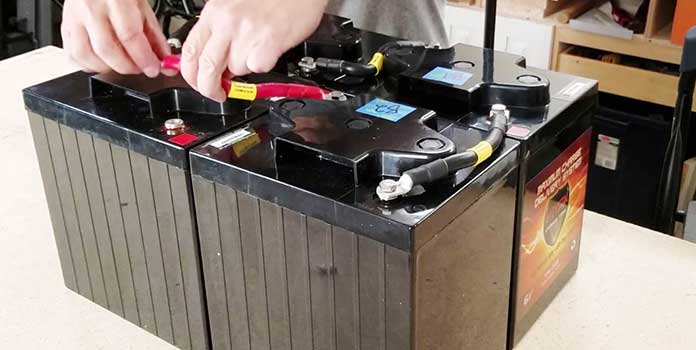
The best deep cycle battery for solar depends on your own situation. If you’re looking to spend as little as possible upfront, flooded lead-acid batteries will fit the bill. If you want a long-term investment and tons of perks that lead-acid can’t offer, look into lithium. If you want a good meeting point of the two – lower initial cost but greater versatility – try out sealed lead-acid batteries.
With all these technologies, there are all manner of quality as well, so be sure to read reviews and talk to an expert or two before making any decisions. As long as you compare prices and read up on reviews – like we did above – you’ll be good to go no matter what!
Have you worked with any of the batteries above? Tell us about your experience in the comments above!
Want to install some solar to go along with your energy storage system? Reach out to a few installers!
Image Credits under CC License via Flickr – 1,2, CC via Wikimedia Commons and Courtesy Trojan Media Press Kit, Simpliphi Media Kit
